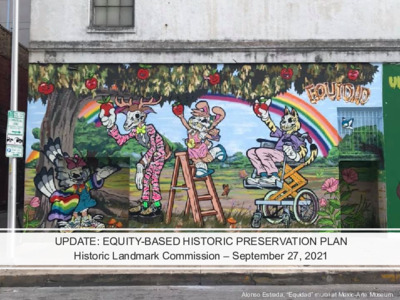4.A.4 - Equity-Based Historic Preservation Plan update — original pdf
Backup

UPDATE: EQUITY-BASED HISTORIC PRESERVATION PLAN Historic Landmark Commission – September 27, 2021 Alonso Estrada, “Equidad” mural at Mexic-Arte Museum bit.ly/ATXpresplan MEETING SCHEDULE Essential Background and Process July 29 Aug. 30 Sept. 23 Introduction and goals Equity workshop Decision-making Topics Oct. 14 Nov. 18 Dec. 9 Jan. 13 Feb. 10 Vision for the plan / Heritage in Austin (part 1) Heritage in Austin (part 2) Preservation tools Processes and fees Community preservation MEETING SCHEDULE Topics (con’t) March 10 April 14 May 12 Review draft plan June 9 Preservation and… Economic development, property rights Outreach, education, and engagement Topic TBD Review compiled recommendations / Discuss next steps MEETING 1: INTRODUCTION + GOALS MEETING 2: EQUITY WORKSHOP MEETING 3: DECISION-MAKING 1. Vision: Does the plan offer a clear vision for historic preservation that can be used by stakeholders to communicate and collaborate? Do all recommendations support that vision? 2. 3. 4. 5. 6. 8. 9. Process: Has the process of developing the preservation plan been welcoming and accessible to community members with a range of viewpoints, regardless of previous preservation experience? Education: Does the plan educate readers about the benefits of historic preservation and how preservation relates to key topics such as property rights, displacement, and affordability? Expansion: Does the plan recognize historically underrepresented people, places, and stories? Does it expand what is considered “historic”? Effectiveness: Are the plan’s recommendations for policies, programs, and incentives grounded in good practices from around the U.S. and the world? Practicality: Does the plan balance big-picture thinking with specific, actionable, measurable recommendations that recognize legal constraints? Does the plan include a realistic strategy for regular updates? 7. Accessibility: Does the plan recommend ways to make historic preservation processes more accessible to community members, especially those who aren’t familiar with the processes? Is the plan itself easy to understand? Equity: Are the expected benefits of the plan’s recommendations equitably distributed? Are negative impacts minimized, particularly for communities that have historically been disadvantaged by public policies? Connection: Does the plan advance livability, affordability, and other community values, particularly for historically underrepresented communities? 10. Support: Is the plan supported by working group members, policymakers, City departments, allied organizations, and community members? MEETING 3: DECISION-MAKING Equity evaluation framework Goal: Ensure that the plan’s recommendations benefit—or at least do not harm—communities of color who have been historically underrepresented in preservation efforts and harmed by previous public policies. EQUITY EVALUATION FRAMEWORK Does the proposed recommendation… 1. Reinforce the plan’s vision? -1 0 +1 No / Neutral Yes / harms benefits 2. Respect community-based knowledge, and is it based on community-identified needs and input? 3. Increase equitable access to information about historic preservation? Is it clear to people without previous preservation experience? 4. Recognize and honor the cultures, historic assets, and traditions of historically underrepresented communities in meaningful ways? 5. Ground its reasoning and expected outcomes in good practices around equity, including racially disaggregated data? 6. Balance big-picture thinking with specific, actionable, measurable items that recognize and redress historical disparities? 7. Improve access to preservation policies, programs, tools, and incentives for BIPOC and low-income communities? 8. Avoid creating financial or other burdens for BIPOC communities and low-income people? If yes, are there opportunities to mitigate these impacts? Does it place responsibility on institutions to address historical disparities in historic preservation policies, programs, and tools? 9. Advance affordability, economic opportunities, and sustainability for everyone, and especially for BIPOC communities? If not, are there opportunities to do so? 10. Engage and empower BIPOC communities to actively participate in implementation? ENGAGEMENT Community heritage survey Focus: vision for plan COMMUNITY HERITAGE SURVEY bit.ly/ATXpres Please: Take the survey by Sunday, October 3 Spread the word Share with your appointing CM COMMISSION + STAFF SURVEY bit.ly/hlchpo Please: Take the survey now to help the working group better understand the composition of the Commission and the Historic Preservation Office